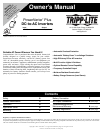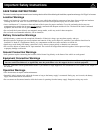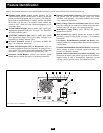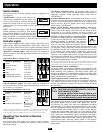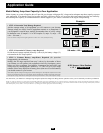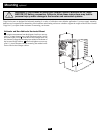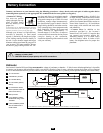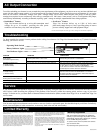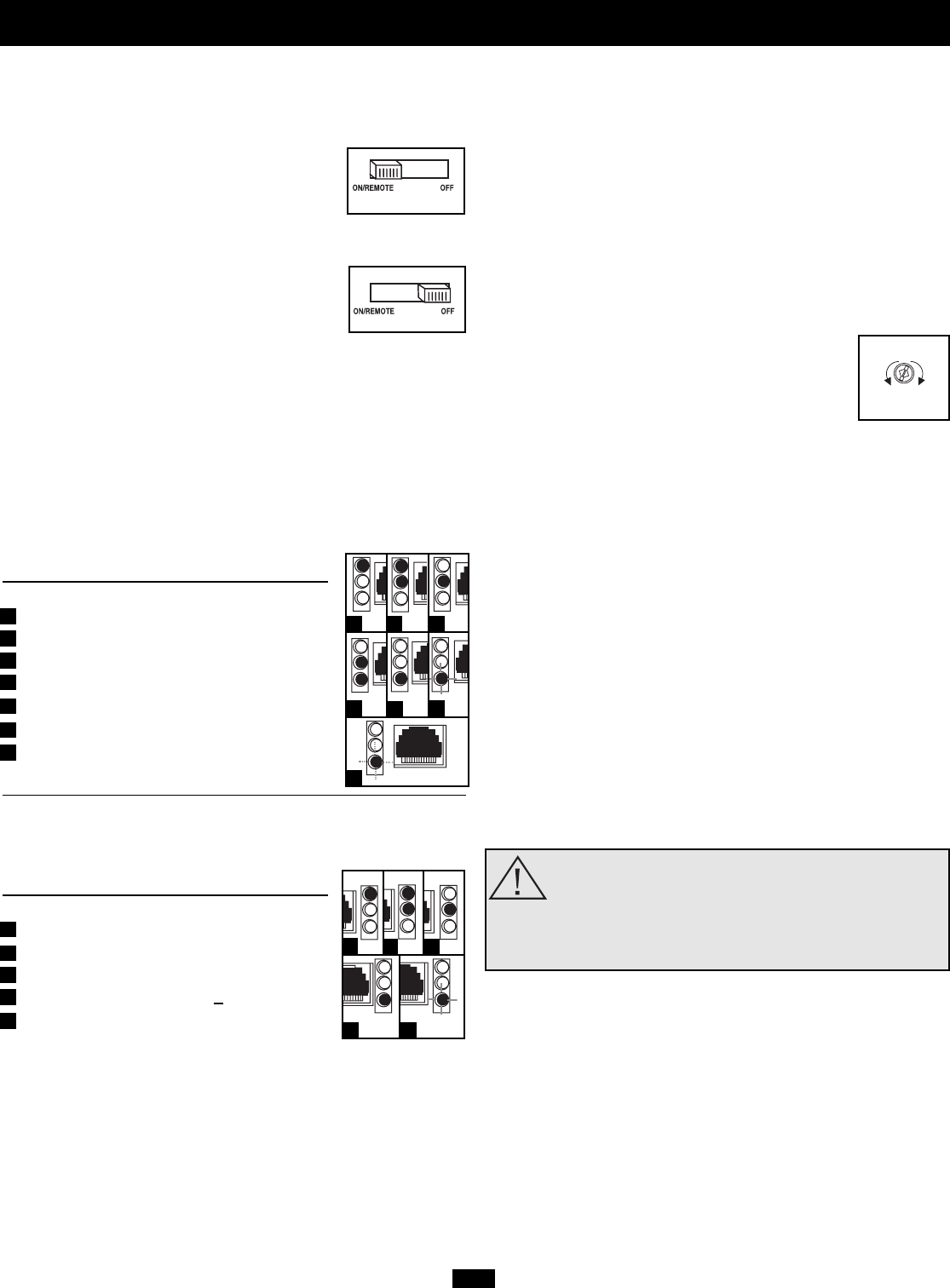
4PV
Operation
Switch Modes
Switch between the following operating modes as appropriate to
your situation:
“ON/REMOTE”: Switch to this setting to pro-
vide connected equipment with AC power. Also,
switch to this setting to remotely monitor and
control the Inverter with the use of an optional
remote module. See remote module’s owner’s manual for operating
instructions.
“OFF”: Switch to this setting to shut down the
Inverter completely, preventing it from drawing
power from the batteries. Use this switch to auto-
matically reset the unit if it shuts down due to low
battery or overload. Use an optional remote control module (Tripp Lite
model APSRM4, sold separately) to reset unit due to overload only.
Indicator Lights
Your Inverter is equipped with a simple, intuitive, user-friendly set of
indicator lights. These easily-remembered “traffic light” signals will
allow you, shortly after first use, to tell at a glance the charge condition
of your batteries, as well as ascertain approximate equipment load level.
“BATTERY” Indicator Lights: These three lights will illuminate in
several sequences to show the approximate charge level of your con-
nected battery:
Approximate Battery Charge Level
†
Indicator Illuminated Battery Capacity
Green 91%–Full
Green & Yellow 81%–90%
Yellow 61%–80%
Yellow & Red 41%–60%
Red 21%–40%
Flashing Red (slowly)* 1%–20%
Flashing Red (quickly)** 0% (Inverter
has shutdown)
“LOAD” Indicator Lights: These three lights will illuminate in
several sequences to show the approximate equipment load level on
the Inverter’s AC receptacles.
Approximate Equipment Load Level
Indicator Illuminated Load Level
Green 0%-50%
Green & Yellow 51%-75%
Yellow 76%-90%
Red >
90%
Flashing Red (quickly)** OVERLOAD
(Inverter has
shutdown)
† Charge levels listed are approximate. Actual conditions vary depending on battery condition
and load. * Approximately ½ second on, ½ second off. ** Approximately ¼ second on, ¼ second
off. See “Resetting Your Inverter to Restore AC Power” to reset after Inverter shut down.
Resetting Your Inverter to Restore
AC Power
Your Inverter may cease supplying AC power in order to protect
itself from overload or to protect your electrical system. To restore
normal functioning:
Low Battery Shutdown Reset: Set operating mode switch to
“OFF” and run vehicle engine to recharge battery. When battery is
adequately charged, switch operating mode switch back to
“ON/REMOTE.”
Overload Shutdown Reset: Set operating mode switch to “OFF”
and remove some of the connected electrical load (ie: turn off some
of the AC devices drawing power which may have caused the over-
load of the unit). Wait one minute, then switch operating mode
switch back to “ON/REMOTE.”
Output Circuit Breaker Reset (Select Models): Alternatively,
check output circuit breaker on the unit’s front panel. If tripped,
remove some of the electrical load, then wait one minute to allow
components to cool before resetting the circuit breaker. See
Troubleshooting for other possible reasons AC output may be absent.
Set Battery Charge Conserver (Load Sense) Dial
In order to save battery power, the Inverter automatical-
ly shuts off in the absence of any power demand from
connected equipment or appliances (the electrical
load). When the unit detects a load, it automatically
turns on. Users may choose the minimum load the
Inverter will detect by adjusting the Battery Charge Conserver Dial
(see diagram). Using a small tool, turn the dial clockwise to lower
the minimum load that will be detected, causing the Inverter to turn
on for smaller loads. When the dial is turned fully clockwise, the
Inverter will operate even when there is no load. Turn the dial counter-
clockwise to set a higher minimum load, causing the Inverter to stay
off until the new minimum load is reached. When the dial is turned
fully counterclockwise, the Inverter will turn on when it detects any
load greater than approximately 150 Watts.
Note: The factory setting for the dial is fully clockwise. However, based on the threshold load to which
you’d like the Inverter to respond, you should adjust the dial counterclockwise to reduce its sensitivity
until the Inverter is active only when connected equipment or appliances are actually in use.
Connect Remote Control—OPTIONAL
All models feature an 8-conductor telephone style receptacle on the
front panel for use with an optional remote control module (Tripp Lite
model APSRM4, sold separately.) The remote module allows the
Inverter to be mounted in a compartment or cabinet out of sight, while
operated conveniently from your vehicle’s dashboard. See instructions
packed with the remote control module.
Connect Ignition Switch Control Jack—OPTIONAL
All models feature a jack which can be used to connect the Inverter to
your vehicle's ignition switch in order to automatically control the
Inverter. This connection is optional; the Inverter will function without
this connection.
WARNING! THE IGNITION SWITCH CONTROL
FUNCTION IS ONLY FOR USE WITH 12V NEGA-
TIVE GROUND SYSTEMS.
Wiring the Ignition Switch Control Cable to your
vehicle’s ignition requires a qualified technician,
who must determine the proper wiring procedure.
When connected to the vehicle’s ignition switch, this function automat-
ically disables (turns OFF) the AC power output from the Inverter when
the vehicle’s ignition switch is placed in the “Engine Run” position.
This function will satisfy local codes and requirements concerning
video monitors (or TVs) that are located within a driver’s view by auto-
matically turning them off when the engine is started. Tripp Lite makes
a current-limited cable assembly (part # 73-0977) for this purpose.
Connect the current-limited cable's red wire to the ignition switch's
"Engine Run" terminal. The cable's black wire can be left unterminated.
Then, connect the current-limited cable's mini-plug to the Ignition
Switch Control Jack located on the Inverter's rear panel. After connect-
ing the interface cable, set the Inverter's switch to "ON/REMOTE". The
current-limited cable's mini-plug should remain in the Inverter's
Ignition Switch Control Jack whenever the ignition is on to avoid short-
ing the battery.
1
2 3
4
5
6
7
LOAD
SENSE
GREATER
LOAD
ON
LESSER
LOAD
ON
1
2
3
4
5
6
7
1
2
3
4
5
1
2 3
4
5



